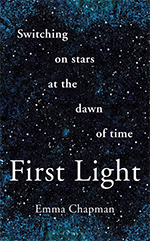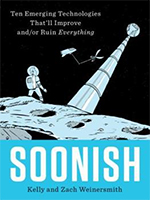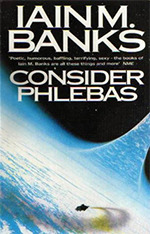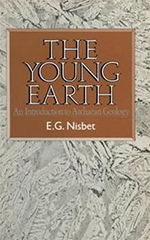18 January 2021
Book report
Posted by Callan Bentley
First Light: Switching on Stars at the Dawn of Time, by Emma Chapman
 Emma Chapman is keen on understanding the first stars. The first stars are different from modern stars, in their composition as well as their size. Specifically, Chapman notes that the earliest stars (unchronologically named Population III in contrast to modern Population I) were huge (20 solar masses) and “burned” (fused) hydrogen for 10 million years, followed by helium for 1 million , and then beryllium → carbon (300 years), oxygen (200 days), and silicon (2 days), for proportionately less and less time in the years remaining to them. Their life cycles went by quickly. Chapman is apparently typical of astronomers in taking anything of higher atomic weight than helium as a “metal,” presenting the astronomer’s periodic table as one of the earliest figures in the book: hydrogen/helium/METALS METALS METALS. What distinguishes the first stars (Population III) from the rest is they had none of these “metals” at their start, just hydrogen. So the search for Population III is really the search for “low metallicity” stars. An extended analogy is offered in one chapter between cyanobacteria polluting their surroundings with oxygen, and Population III stars polluting the interstellar medium with metals. Just as stromatolites changed the ambient geochemical conditions on Earth forever, so too did Population III stars forever alter the cosmic trajectory by contaminating it with metals of their own generation. Archaeology gets invoked as an analogy too – how can an Egyptologist figure out what’s pristine about a newly discovered tomb, what’s been extracted by grave robbers, and what’s been introduced as more recent contributions? A similar task faces astronomers as they consider the various aspects of electromagnetic radiation they gather from the cosmos. The final chapter looks ahead to future missions / experiments, describing their intended design and what data they seek. All told, I found this to be an excellent book: it’s more detailed than something general, the sort of thing Neil Degrasse Tyson might write. Chapman writes about the search that motivates her whole career, and she writes with a zippy, cheeky passion that’s infectious.
Emma Chapman is keen on understanding the first stars. The first stars are different from modern stars, in their composition as well as their size. Specifically, Chapman notes that the earliest stars (unchronologically named Population III in contrast to modern Population I) were huge (20 solar masses) and “burned” (fused) hydrogen for 10 million years, followed by helium for 1 million , and then beryllium → carbon (300 years), oxygen (200 days), and silicon (2 days), for proportionately less and less time in the years remaining to them. Their life cycles went by quickly. Chapman is apparently typical of astronomers in taking anything of higher atomic weight than helium as a “metal,” presenting the astronomer’s periodic table as one of the earliest figures in the book: hydrogen/helium/METALS METALS METALS. What distinguishes the first stars (Population III) from the rest is they had none of these “metals” at their start, just hydrogen. So the search for Population III is really the search for “low metallicity” stars. An extended analogy is offered in one chapter between cyanobacteria polluting their surroundings with oxygen, and Population III stars polluting the interstellar medium with metals. Just as stromatolites changed the ambient geochemical conditions on Earth forever, so too did Population III stars forever alter the cosmic trajectory by contaminating it with metals of their own generation. Archaeology gets invoked as an analogy too – how can an Egyptologist figure out what’s pristine about a newly discovered tomb, what’s been extracted by grave robbers, and what’s been introduced as more recent contributions? A similar task faces astronomers as they consider the various aspects of electromagnetic radiation they gather from the cosmos. The final chapter looks ahead to future missions / experiments, describing their intended design and what data they seek. All told, I found this to be an excellent book: it’s more detailed than something general, the sort of thing Neil Degrasse Tyson might write. Chapman writes about the search that motivates her whole career, and she writes with a zippy, cheeky passion that’s infectious.
Soonish, by Kelly and Zach Weinersmith
 I’m delighted that in moving to Albemarle County, I’ve got the Weinersmiths as neighbors. Their daughter is not too much younger than my son, and both families have taken a similar approach to the COVID-19 pandemic, leading us into isolation, but that’s bad for the kids, so we get together weekly for well-ventilated hikes at the land around one or another’s house. Zach writes the popular webcomic Saturday Morning Breakfast Cereal, and Kelly is a parasitologist. They both describe themselves as nerds. This book, their first joint collaboration, is an exploration of ten emerging technologies. They look at cheap space travel, mining asteroids, programmable matter, augmented reality, synthetic biology, and personalized medicine. The value of this book is that the two authors are extremely fastidious about tracking down true source material, and striving very much to not be wrong. But that scholarly dedication doesn’t imply a staid or stuffy book. Far from it, the text is laden with goofy jokes and evocative analogies, and every few pages is one of Zach’s cartoons. The humor is like the compressed air beneath a hovercraft – it lofts the whole narrative up, and carries it along through a tremendous review of the relevant literature. The Weinersmiths have made great use of footnotes, too – each contains a pithy clarification, an odd tangent, or an amusing joke. Super enjoyable, and super informative.
I’m delighted that in moving to Albemarle County, I’ve got the Weinersmiths as neighbors. Their daughter is not too much younger than my son, and both families have taken a similar approach to the COVID-19 pandemic, leading us into isolation, but that’s bad for the kids, so we get together weekly for well-ventilated hikes at the land around one or another’s house. Zach writes the popular webcomic Saturday Morning Breakfast Cereal, and Kelly is a parasitologist. They both describe themselves as nerds. This book, their first joint collaboration, is an exploration of ten emerging technologies. They look at cheap space travel, mining asteroids, programmable matter, augmented reality, synthetic biology, and personalized medicine. The value of this book is that the two authors are extremely fastidious about tracking down true source material, and striving very much to not be wrong. But that scholarly dedication doesn’t imply a staid or stuffy book. Far from it, the text is laden with goofy jokes and evocative analogies, and every few pages is one of Zach’s cartoons. The humor is like the compressed air beneath a hovercraft – it lofts the whole narrative up, and carries it along through a tremendous review of the relevant literature. The Weinersmiths have made great use of footnotes, too – each contains a pithy clarification, an odd tangent, or an amusing joke. Super enjoyable, and super informative.
Consider Phlebas, by Iain M. Banks
 Many moons ago in the middle of the pandemic, I asked for recommendations about books to read, and this science fiction novel was recommended on the basis of the fact that one of its scenes took place “in a batholith.” That’s all I knew about it going in, but I was able to get a paperback copy for a few bucks, so why not? It turns out this is the first novel in a series of books, all set in the future of what appears to be our galaxy. This one details a minor plot point in a larger war between two societies. The arc of the story follows the efforts of an agent on one side of this conflict in his attempts to locate and capture a self-contained artificial intelligence capsule developed by the other side. (It is this AI, called a “Mind,” that has hidden itself in a tunnel system that was bored into the cited batholith.) It turns out to be quite a series of adventures for the agent to get to the Mind and extract it. It’s a high adrenaline book with a lot of violent and spectacular occurrences, and pluck and luck on the part of the protagonist. Many of Banks’ details are familiar (trains, for instance), but others are imaginative and original (the idea of ring-shaped planet-equivalents called orbitals). It manages to feel distinctly alien while also resonating as relevant to a human at the same time. I wasn’t thrilled with the ending, but the reading of the novel was enjoyable and escapist.
Many moons ago in the middle of the pandemic, I asked for recommendations about books to read, and this science fiction novel was recommended on the basis of the fact that one of its scenes took place “in a batholith.” That’s all I knew about it going in, but I was able to get a paperback copy for a few bucks, so why not? It turns out this is the first novel in a series of books, all set in the future of what appears to be our galaxy. This one details a minor plot point in a larger war between two societies. The arc of the story follows the efforts of an agent on one side of this conflict in his attempts to locate and capture a self-contained artificial intelligence capsule developed by the other side. (It is this AI, called a “Mind,” that has hidden itself in a tunnel system that was bored into the cited batholith.) It turns out to be quite a series of adventures for the agent to get to the Mind and extract it. It’s a high adrenaline book with a lot of violent and spectacular occurrences, and pluck and luck on the part of the protagonist. Many of Banks’ details are familiar (trains, for instance), but others are imaginative and original (the idea of ring-shaped planet-equivalents called orbitals). It manages to feel distinctly alien while also resonating as relevant to a human at the same time. I wasn’t thrilled with the ending, but the reading of the novel was enjoyable and escapist.
The Young Earth: An introduction to Archaean geology, by E.G. Nesbit
 This is an accounting of Archean geology by one of its practitioners. It covers igneous, sedimentary, and metamorphic processes relating to the Archean, with particular attention given to TTG suites, komatiites, stromatolites, distinctive characteristics of Archean sediments, iron formations, and the fossils of ancient microbial life. It was surprisingly readable for an academic work. It felt a bit dated (it was published in 1987), but it felt authentic and informed too. I am glad to have read it – it definitely expanded my horizons beyond the Canadian and South African outcrops I know to emphasize Australia, Greenland, and Mozambique — but I would be even more glad for a 2021 2nd edition!!
This is an accounting of Archean geology by one of its practitioners. It covers igneous, sedimentary, and metamorphic processes relating to the Archean, with particular attention given to TTG suites, komatiites, stromatolites, distinctive characteristics of Archean sediments, iron formations, and the fossils of ancient microbial life. It was surprisingly readable for an academic work. It felt a bit dated (it was published in 1987), but it felt authentic and informed too. I am glad to have read it – it definitely expanded my horizons beyond the Canadian and South African outcrops I know to emphasize Australia, Greenland, and Mozambique — but I would be even more glad for a 2021 2nd edition!!


 Callan Bentley is Associate Professor of Geology at Piedmont Virginia Community College in Charlottesville, Virginia. He is a Fellow of the Geological Society of America. For his work on this blog, the National Association of Geoscience Teachers recognized him with the James Shea Award. He has also won the Outstanding Faculty Award from the State Council on Higher Education in Virginia, and the Biggs Award for Excellence in Geoscience Teaching from the Geoscience Education Division of the Geological Society of America. In previous years, Callan served as a contributing editor at EARTH magazine, President of the Geological Society of Washington and President the Geo2YC division of NAGT.
Callan Bentley is Associate Professor of Geology at Piedmont Virginia Community College in Charlottesville, Virginia. He is a Fellow of the Geological Society of America. For his work on this blog, the National Association of Geoscience Teachers recognized him with the James Shea Award. He has also won the Outstanding Faculty Award from the State Council on Higher Education in Virginia, and the Biggs Award for Excellence in Geoscience Teaching from the Geoscience Education Division of the Geological Society of America. In previous years, Callan served as a contributing editor at EARTH magazine, President of the Geological Society of Washington and President the Geo2YC division of NAGT.